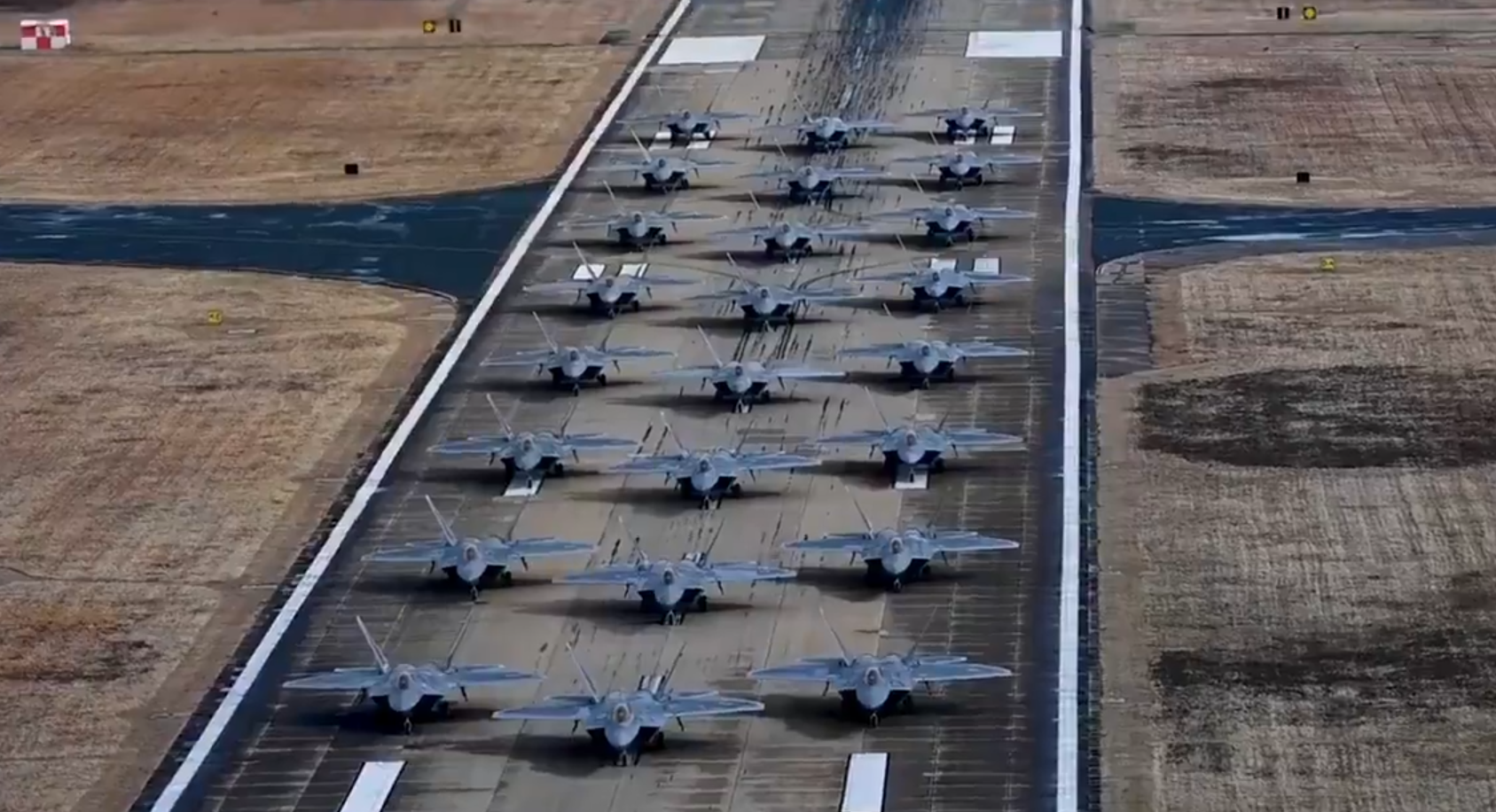Decoding the Pentagon's F-22 Raptor Video: A Deep Dive into US Military Strategy and Technological Prowess
The release of a high-profile video showcasing the F-22 Raptor, the apex of American air superiority, by the Pentagon is far more than just a display of technological prowess. It's a carefully orchestrated strategic communication, a message sent rippling across the globe, intended to reassure allies, deter adversaries, and solidify the United States' position as a leading military power in an increasingly complex and volatile world. Understanding the context, capabilities, and implications of this video requires a deep dive into the current geopolitical landscape, the technological advancements embodied by the F-22, and the overarching strategies that guide U.S. defense policy.
WOW!!
— Open Source Intel (@Osint613) February 11, 2025
The Pentagon just dropped this video.
What’s the message? pic.twitter.com/yPcP2v6Trq
The Geopolitical Stage: Tensions and Re-evaluations
The timing of this video's release is crucial. It arrives against a backdrop of escalating global military tensions, particularly in regions strategically vital to U.S. interests. The South China Sea, a flashpoint of territorial disputes and assertive Chinese expansion, remains a key area of concern. The Middle East, perpetually embroiled in conflict and power struggles, continues to demand U.S. attention and involvement. In these regions, the U.S. seeks to maintain its influence, project its power, and safeguard its allies. The F-22 Raptor video serves as a visual reminder of the capabilities the U.S. possesses to achieve these objectives.
Furthermore, the video surfaces amidst a period of critical self-reflection and strategic re-evaluation within the U.S. defense establishment. Publications like "After primacy: US military options in contemporary East Asia" highlight a growing awareness of the shifting balance of power. The rise of China, the resurgence of Russia, and the proliferation of advanced military technologies necessitate a reassessment of traditional strategies and a willingness to adapt to new realities. The F-22, as a symbol of American technological superiority, plays a significant role in this re-evaluation, representing a key asset in maintaining a competitive edge.

The F-22 Raptor: A Technological Marvel
The F-22 Raptor, meticulously crafted by Lockheed Martin, is not merely an aircraft; it's a technological marvel, a fifth-generation air superiority fighter designed to dominate the skies. Its defining characteristic is its advanced stealth technology, which renders it incredibly difficult to detect by enemy radar systems. This stealth capability allows the F-22 to penetrate heavily defended airspace, conduct reconnaissance missions, and strike targets with minimal risk of detection. This is a crucial advantage in modern warfare, where early detection and rapid response are paramount.
Beyond stealth, the F-22 boasts exceptional maneuverability, advanced avionics, and a powerful suite of sensors. Its engines provide unmatched thrust, allowing it to achieve supersonic speeds without the need for afterburners, further enhancing its stealth capabilities. The cockpit is equipped with state-of-the-art displays and controls, providing pilots with unparalleled situational awareness. Its advanced radar system can track multiple targets simultaneously, engaging them with precision-guided missiles.
The F-22's technological superiority has made it a cornerstone of U.S. military dominance. It represents a significant investment in research and development, reflecting the U.S.'s commitment to maintaining a technological edge over potential adversaries. The video released by the Pentagon serves as a visual demonstration of this investment, showcasing the capabilities that make the F-22 such a formidable asset.
"Peace Through Strength": A Doctrine Reaffirmed
The release of the F-22 Raptor video can be interpreted as a modern reaffirmation of the "Peace through strength" doctrine. This concept, deeply rooted in history and popularized in modern U.S. politics by figures like Ronald Reagan, argues that military strength is the best deterrent to aggression and the surest path to maintaining peace. The video, by showcasing the advanced capabilities of the F-22, sends a clear message to potential adversaries: the U.S. possesses the military might to defend its interests and deter aggression.
The "Peace through strength" doctrine is not without its critics. Some argue that it can lead to an arms race, escalating tensions and increasing the risk of conflict. Others contend that it can be used as a justification for military interventionism, undermining international law and stability. However, proponents of the doctrine maintain that a strong military is essential for deterring aggression and protecting national interests in a dangerous world. The Pentagon's video, in their view, is a responsible exercise of this doctrine, a demonstration of strength intended to prevent conflict rather than provoke it.
Agile Combat Employment: Adapting to Modern Warfare
Recent developments in the deployment of F-22s, including their participation in exercises like Agile Combat Employment (ACE), highlight a shift towards more flexible and rapid deployment tactics. ACE is a concept that emphasizes the ability to rapidly deploy small teams of personnel and equipment to austere locations, enabling them to operate independently and maintain combat effectiveness. This approach reduces logistical footprints, increases survivability, and allows for a more dispersed and resilient force posture.
The F-22, with its advanced capabilities and relatively small logistical footprint, is ideally suited for ACE operations. Its ability to operate from forward operating locations, even those with limited infrastructure, makes it a valuable asset in rapidly responding to emerging threats. The Pentagon's video, by showcasing the F-22's capabilities, also implicitly promotes the ACE concept, signaling a shift towards a more agile and adaptable military force.
Deterrence and Power Projection: Sending a Clear Message
The primary purpose of the F-22 Raptor video is likely deterrence. It serves as a signal of readiness and capability to potential adversaries, demonstrating the U.S.'s ability to project power swiftly and decisively. The video showcases the F-22's advanced technology, its exceptional performance, and its ability to operate in a variety of environments. This visual display of power is intended to dissuade potential adversaries from taking actions that could threaten U.S. interests or the interests of its allies.
The video also serves as a tool for power projection. By showcasing the F-22's capabilities, the U.S. is demonstrating its commitment to maintaining a strong military presence in key regions around the world. This presence serves to reassure allies, deter potential aggressors, and maintain stability in volatile areas. The F-22, as a symbol of American technological superiority, is a powerful tool for projecting power and influence on the global stage.
Beyond Air Superiority: Multi-Role Capabilities
While the F-22 is primarily designed for air superiority, its role extends beyond simply dominating the skies. It has also been involved in ground attack missions, demonstrating its multi-role capabilities. For example, F-22s have been deployed in Afghanistan alongside B-52 bombers, targeting Taliban-controlled opium facilities. This highlights the F-22's versatility and its ability to contribute to a wide range of military operations.
The F-22's ability to perform both air-to-air and air-to-ground missions makes it a valuable asset in a variety of scenarios. It can be used to establish air superiority, suppress enemy air defenses, and strike ground targets, all in a single mission. This multi-role capability enhances its effectiveness and makes it a more valuable asset to the U.S. military.
Continuous Technological Advancement: Maintaining the Edge
The F-22 is not a static platform; it is constantly being upgraded and improved to maintain its technological edge. Technological advancements in stealth, payload capacity, and combat radius are continuously being explored. One area of particular interest is the development of stealthy external carriage systems, which would allow the F-22 to carry additional weapons without compromising its stealth features.
These ongoing efforts to improve the F-22 demonstrate the U.S.'s commitment to maintaining its technological superiority. By continuously investing in research and development, the U.S. seeks to ensure that the F-22 remains the most advanced air superiority fighter in the world for years to come.
Strategic Deployment: Responding to Global Shifts
The strategic deployment of F-22s in various regions around the world underscores the U.S.'s commitment to its allies and its readiness to respond to threats beyond its traditional areas of operation. For example, F-22s have been deployed to Europe to participate in NATO exercises in response to geopolitical shifts, such as the annexation of Crimea.
These deployments send a clear message to potential adversaries that the U.S. is prepared to defend its allies and deter aggression. The F-22, as a symbol of American power and technological prowess, plays a key role in this strategic signaling.
Conclusion: A Multifaceted Message
The Pentagon's release of the F-22 Raptor video is a multifaceted message intended to achieve a variety of strategic objectives. It serves as a visual demonstration of American technological superiority, a reaffirmation of the "Peace through strength" doctrine, a signal of readiness and capability to potential adversaries, and a tool for projecting power and influence on the global stage. By understanding the context, capabilities, and implications of this video, we can gain a deeper appreciation for the complexities of U.S. defense policy and the role that advanced military technology plays in shaping the international landscape. The F-22 Raptor, in this context, is more than just an aircraft; it's a symbol of American power, a deterrent to aggression, and a key component of U.S. strategy in an increasingly uncertain world. The continuous development and strategic deployment of the F-22 underscore the enduring commitment of the United States to maintaining its position as a leading military power and safeguarding its interests and the interests of its allies around the globe. The video, therefore, is not just a showcase of technology; it is a carefully calibrated message designed to shape perceptions, influence behavior, and ultimately, contribute to a more secure and stable world.


